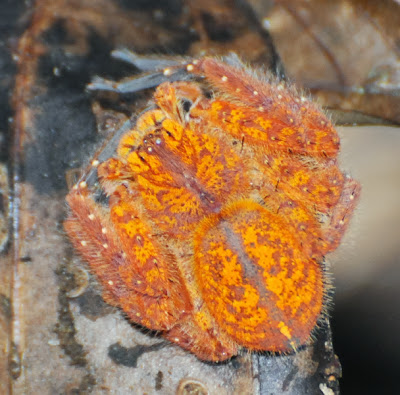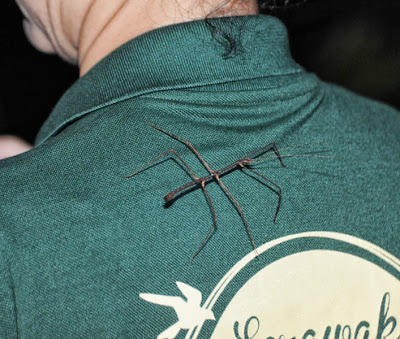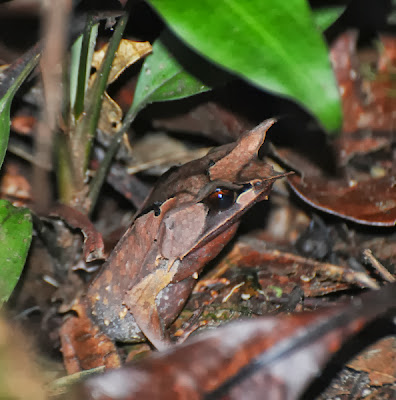The easiest animals to find on a night walk are usually spiders. First of all, there are lots of them, and second, their eyes reflect particularly brightly in the light of a headlamp, making you think, of course, that you may have found a much larger creature. When your light reveals only a wolf spider like this one, it can be a bit disappointing (fascinating though spiders may be).
Some of the spiders that your lights turn up, though, can be spectacular in themselves.
This one, for example, had us all crowding around for a closeup photo. It is apparently a Huntsman or Giant Crab Spider (Sparassidae), though I do not know precisely which. A very similar spider from West Malaysia and Singapore, described in 2009, was named Heteropoda davidbowie (yes, after the equally flamboyant singer), and perhaps that is, indeed, what this is.
This is not a spider, but a harvestman (or opilionid).
One of our odder finds was a particularly elaborate centipede wandering about in the middle of a trailside bush. It seems to be a member of the Scutigeridae, the long-legged house centipedes, but it is certainly more spectacular than any scutigerid I have come across (usually while it was scurrying around in the bathtub).
We came across a variety of insects, from the unobtrusive to the spectacular. Here are a ground-living cricket, and what appears to be an arboreal bush cricket or katydid.
The ants swarming over this plant's inflorescence may be its pollinators. The plant is certainly secreting something that attracts them, whether to carry its pollen, or for some other reason - I wish I knew more!
On the spectacular side, though, the clear winners among the Invertebrata were the stick insects. Borneo has an amazing variety of them - these two photos may give you some idea of that.
The one that had everyone in our party excited, though, was the peculiarly-named Jungle Nymph (Heteropteryx dilatata).
This is an immature male (adult males have wings); the bright green, far larger females are the heaviest stick insects in the world.
Getting on close terms with this one was quite an experience, especially for the younger members of our group!
With two herpetologists as our guides, though, we were not about to be satisfied with invertebrates. Fortunately, Hans and Sam turned up a Cat Gecko (Aeluroscalabotes felinus), a highly distinctive (and apparently fairly primitive) gekkonid lizard that has been placed in its own subfamily. Cat Geckos are found through much of southeast Asia, where they prefer montane forest (so we were in the right place to see one).
Sam, being a frog expert, found a number of interesting amphibians for us. This one, an unidentified species of Meristogenys (one of the "true" frogs of the family Ranidae), we found on the eway to the trailhead. Thanks to Sam and to Indraneil Das, by the way, for the identifications!
The Four-lined Tree Frog (Polypedates leucomystax) is a member of the largely Asian family Rhacophoridae. It is a common associate of humans, and prefers places like the streams bordering the golf course to the forest itself.
We found two species of another "true" frog genus, Hylarana. This strikingly-patterned creature is a Spotted Stream Frog (Hylarana picturata)
This more sedately-patterned individual is a White-lipped Frog (Hylarana raniceps).
We found this interesting little toad in the litter higher up on the trail. Though it is similar to the Lowland Dwarf Toad (Pelophyryne signata), it is, according to Neil Das, a new species, yet to be described.
Pelophryne toads are confined to the Philippines, Borneo, West Malaysia, Singapore and Hainan Island in China. There are eight currently-recognized species in Borneo, but as for many Bornean amphibians we still have a lot to learn about how diverse they really are. Even some of the species with scientific names have only received them in the last few years.
Finding an undescribed species was, from the strictly scientific point of view, the high point of our walk. However, the children in our group, including Ryan and, I suppose, yours truly, were more impressed by our guides' ability to turn up several individuals of a much better-known creature, skulking in the leaf litter along the trail.
Borneo (or Malayan, or Long-nosed) Horned Frogs (Megophrys nasuta) are amazing-looking animals. Based on calls alone, they must be abundant in the forests around Kuching, but they are such masters of camouflage that they can be the very devil to spot as they sit on the forest floor waiting for something edible to happen by.
Frogs aren't supposed to have facial expressions; but I can't help thinking that this one was not at all sorry to see us head back down the trail and leave it alone.























+DSC_4447_resize.JPG)


+DSC_4382_resize.JPG)
+DSC_4394_resize.JPG)









The variety of the organisms you encountered during that single walk is unbelievable. I love your photos, you happened to capture some of my most favourite animal groups.
ReplyDeleteHello Ron, I love your photo shot of this remarkable, exceptional camouflage frog on the dead leaf litter. I ask for your permission to use this photo to append to my non-monentary value poem I submit at Fanstory.com You may contact me at wqandt@yahoo.com for your response, I will submit it there until I hear from you. Thanks again and I am glad you share this to the public.
ReplyDelete